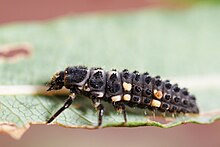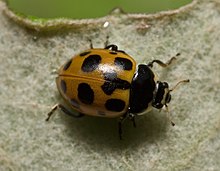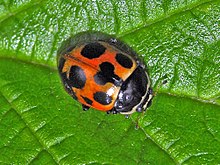Hippodamia notata
| Hippodamia notata | |
|---|---|
 | |
| Adult of Hippodamia notata | |
| Scientific classification | |
| Domain: | Eukaryota |
| Kingdom: | Animalia |
| Phylum: | Arthropoda |
| Class: | Insecta |
| Order: | Coleoptera |
| Infraorder: | Cucujiformia |
| Family: | Coccinellidae |
| Genus: | Hippodamia |
| Species: | H. notata |
| Binomial name | |
| Hippodamia notata (Laicharting, 1781) | |
| Synonyms | |
| |
Hippodamia notata is a species of ladybird belonging to the family Coccinellidae.[1]
Varieties
- Hippodamia notata var. c-nigrum Della Beffa
- Hippodamia notata var. elongata Weise
- Hippodamia notata var. quinquesignata Friv.
Description
Hippodamia notata can reach a length of 4.5–5.5 millimetres (0.18–0.22 in).[2] Adults have domed backs, mainly oval, with short legs and antennae. Pronotum is predominantly black, with white markings on the front edge. This species exhibits a remarkable variability of elytral color patterns. Elytra may be yellow-orange to red and wear large black spots. The legs are black, partially brown, the antennae are also brown. The larvae are slightly flattened and covered with miniature spines.
Distribution
This species is present in most of Europe, in the East Palearctic ecozone and in the Near East.[3] It mainly inhabits forest edges and clearings.
Biology
Like most ladybugs, this species feeds on the larvae and adults of aphids.
Gallery
-
 Larva
Larva -
 Orange variant
Orange variant - Red variant
-
 Yellow variant
Yellow variant
Bibliography
- Georg Möller, Reiner Grube, Ekkehard Wachmann: Der Fauna Käferführer I - Käfer im und am Wald Fauna-Verlag, Nottuln 2006, ISBN 3-935980-25-6.
References
External links
- Variability of elytral color patterns in ladybirds – kerbtier.de
- v
- t
- e
















